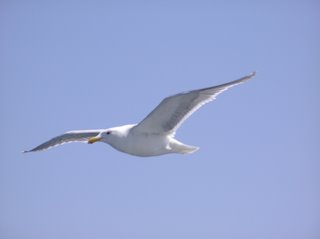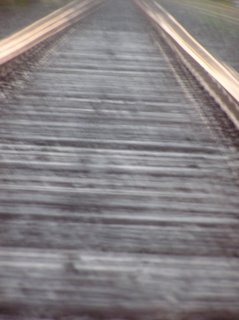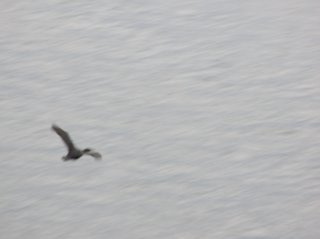Vis In Exilitatem
"I believe in equality for everyone, except reporters and photographers." - Mahatma Gandhi
Tuesday, April 25, 2006
Monday, April 24, 2006
Dinner, Anyone?
 Echinoderms have been compared to living, moving castles. Castles are made of interlocking blocks, with a single main entrance and numerous slit windows for air and for defense. Echinoderm skeletons are made up of interlocking calcium carbonate plates and spines. This skeleton is enclosed by the epidermis and is thus an endoskeleton. In some, such as sea urchins, the plates fit together tightly. In others, such as starfish, the plates are more loosely bound, and in sea cucumbers the plates are usually microscopic. But whatever their shape, the plates of echinoderms have a very typical microstructure: electron microscopy reveals them to be, not solid blocks, but fine networks of calcium carbonate forming a structure known as stereom. Each skeletal element of an echinoderm is actually a single crystal of calcium carbonate, very finely branched and structured.
Echinoderms have been compared to living, moving castles. Castles are made of interlocking blocks, with a single main entrance and numerous slit windows for air and for defense. Echinoderm skeletons are made up of interlocking calcium carbonate plates and spines. This skeleton is enclosed by the epidermis and is thus an endoskeleton. In some, such as sea urchins, the plates fit together tightly. In others, such as starfish, the plates are more loosely bound, and in sea cucumbers the plates are usually microscopic. But whatever their shape, the plates of echinoderms have a very typical microstructure: electron microscopy reveals them to be, not solid blocks, but fine networks of calcium carbonate forming a structure known as stereom. Each skeletal element of an echinoderm is actually a single crystal of calcium carbonate, very finely branched and structured.Between the skeletal plates, a number of special structures protrude, with which the echinoderm breathes, moves, and defends itself. Typically, these are tube feet, pedicellaria, and gills. All echinoderms have a water-vascular system, a set of water-filled canals branching from a ring canal that encircles the gut. The canals lead to podia, or tube feet, which are sucker-like appendages that the echinoderm can use to move, grip the substrate, or manipulate objects. These tube feet are extended and retracted by hydraulic pressure in the water-vascular system. Pedicellaria are small, snapper-like skeletal elements that are used by the echinoderm to keep small organisms from settling on its body.
Echinoderms also have a spacious coelom (an open, fluid-filled body cavity lined with tissue), large gonads, and (usually) a complete gut. Many starfish have the peculiar ability to feed by turning the stomach inside out through the mouth; sea urchins scrape algae from rocks with five large teeth arranged in a structure known as "Aristotle's lantern." Echinoderms (except holothurians) generally lack respiratory systems, and many have only rudimentary circulatory systems; the water-vascular system takes over some of the functions of these systems. Nervous and sensory systems are generally poorly developed in echinoderms.
Sunday, April 23, 2006
Block and Tackle
 A block and tackle (pronounced "block and take-el") is a system of two or more pulleys with a rope or cable threaded between them, usually used to lift or pull heavy loads. Although used in many situations, they are especially common on boats and sailing ships, where motorized aids are usually not available, and the task must be performed manually. The block and tackle pulley was invented by Archimedes.
A block and tackle (pronounced "block and take-el") is a system of two or more pulleys with a rope or cable threaded between them, usually used to lift or pull heavy loads. Although used in many situations, they are especially common on boats and sailing ships, where motorized aids are usually not available, and the task must be performed manually. The block and tackle pulley was invented by Archimedes. The most common arrangement is to have a set of fixed pulleys or "sheaves" all mounted on a single axle, and another set left to move. Each set is called a "block" (the whole assembly, with the rope, is the "tackle"). The mechanical advantage of a block and tackle is equal to the number of lines running between the two blocks. For example, a block and tackle consisting of three fixed and three moving pulleys has six lines going between the pulleys, which gives it a mechanical advantage of 6. This enables the lifting of weights six times heavier than would be possible otherwise.
The increased force produced by a block and tackle is offset by the increased length of rope needed. In order to raise a block and tackle with a mechanical advantage of 6 a distance of 1 metre, it is necessary to pull 6 metres of rope through the blocks.
Saturday, April 22, 2006
Companioned By The Sea
My little house rides like a gull
High on the shore above the bay
By the slow passage of the tides
I measure out my day
There is much that life withholds
There is much that life denies
I am content, and most content
With seaward gazing eyes
My dreams sail with the tall white ships
Though I must ever bide at home
I share the blue of singing space
The bitter kiss of foam
The pageantry of storm and cloud
The mystery of the ebb and flow
The song of water as I sleep
All of these I know
No lesser joy can dim the spell
Of quietly enchanted hours
When the sea wore reflected stars
Upon her breast like flowers
Brine scented dawns, seafaring greens
How richly these have dowered me
That I should go through all my days
Companioned by the sea
Marjorie Howell
Thursday, April 20, 2006
Sunday, April 16, 2006
The Silent Tide

I heard Old Ocean raise her voice and cry,
In that still hour between the night and day;
I saw the answering tides, green robed and gray,
Turn to her with a low contented sigh;
Marching with silent feet they passed me by,
For the white moon had taught them to obey,
And scarce a wavelet broke in fretful spray,
As they went forth to kiss the stooping sky.
So, to my heart, when the last sunray sleeps,
And the wan night, impatient for the moon,
Throws her gray mantle over land and sea,
There comes a call from out Life's nether deeps,
And tides, like some old ocean in a swoon,
Flow out, in soundless majesty, to thee.
The Silent Tide
An Anthology of Australian Verse
Saturday, April 15, 2006
Friday, April 14, 2006
Cosmic Holly
 Today is, for some of us, the end of Lent. This is the first year I've observed Lent, and I chose one of my closest allies to do without for forty days: coffee. In some ways it seems like it's been forever since I've had my traditional amaretto or hazelnut soy latte, and yet at the same time I'm surprised that forty days has already passed. What does this have to do with this picture? Absolutely nothing.
Today is, for some of us, the end of Lent. This is the first year I've observed Lent, and I chose one of my closest allies to do without for forty days: coffee. In some ways it seems like it's been forever since I've had my traditional amaretto or hazelnut soy latte, and yet at the same time I'm surprised that forty days has already passed. What does this have to do with this picture? Absolutely nothing.Thursday, April 13, 2006
Tuesday, April 11, 2006
Seaside Nap
 I came across this photo as I was browsing an old partition on my computer, and I don't think I've ever published it. Last Summer I took a day-hike on Dungeness Spit, near Sequium, Washington, on the Olympic Peninsula. This little guy was snoring a few feet above the surf, and I stopped at a distance to take a few pictures. As the tide came in, the water began to tickle his side. He would shift uncomfortably up the beach, keeping his eyes closed so as to postpone waking at all costs. After a few minutes of this, realizing that the water wasn't going to leave him alone, he opened his eyes and started calling out faintly. As I stood and watched, he began to shuffle up the beach toward me, stopping two feet in front of me! At that point I'd abandoned taking pictures and stood there simply awed by the experience of being so close to this beautiful creature. Later in the afternoon I watched from afar as he tried to swim out into the Strait, thwarted by the prevailing waves which washed him right back to where he started.
I came across this photo as I was browsing an old partition on my computer, and I don't think I've ever published it. Last Summer I took a day-hike on Dungeness Spit, near Sequium, Washington, on the Olympic Peninsula. This little guy was snoring a few feet above the surf, and I stopped at a distance to take a few pictures. As the tide came in, the water began to tickle his side. He would shift uncomfortably up the beach, keeping his eyes closed so as to postpone waking at all costs. After a few minutes of this, realizing that the water wasn't going to leave him alone, he opened his eyes and started calling out faintly. As I stood and watched, he began to shuffle up the beach toward me, stopping two feet in front of me! At that point I'd abandoned taking pictures and stood there simply awed by the experience of being so close to this beautiful creature. Later in the afternoon I watched from afar as he tried to swim out into the Strait, thwarted by the prevailing waves which washed him right back to where he started.











